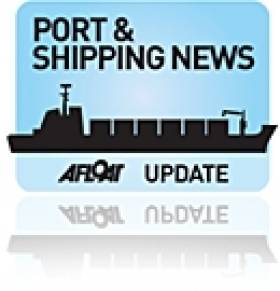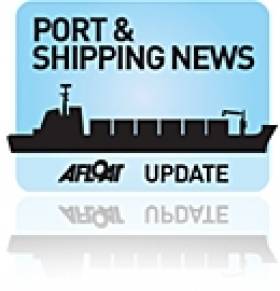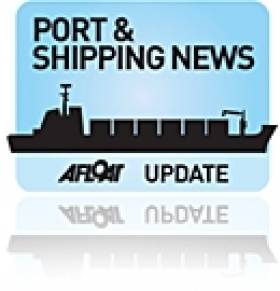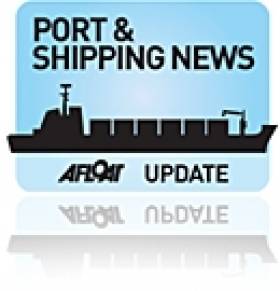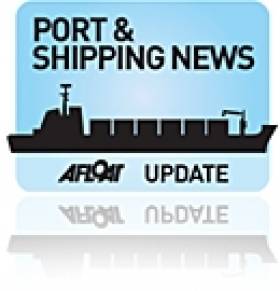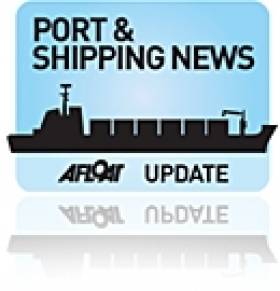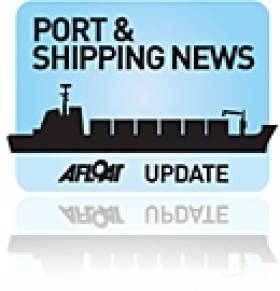Displaying items by tag: IMDO Shipping Review
IMDO Shipping Review: “Sail” Cargoships, Dry-Bulker Slump, LNG Fuel the Future and more
#Ports&Shipping –The latest IMDO Weekly Shipping Market Review includes the following stories as detailed below.
Innovation: "Sails" tested for energy-efficient cargo shipping - A new wind-power project which would see cargo ships using sails to aid in propulsion could cut fuel costs by 30% and revolutionize maritime shipping, according to newspaper Asahi. The project, run by stakeholders from the private sector and academia, aims to develop a next-generation cargo ship with fiber-reinforced plastic sails to aid propulsion. Research group leader, Kazuyuki Ouchi said "The plan is to use the wind that had been a barrier to navigation until now as an energy source and to turn it into a power that can change the concept of ships."
Dry Bulk Market: Bulk rates slump in January- The Baltic Dry Index (BDI), a measure of the cost of transporting raw materials such as metals, grains and fossil fuels by sea, fell 13% last week, adding to the general decline in the market which has seen the index fall 48% since the start of the New Year.
Fuel: Alternative fuels for shipping explored - Liquefied Natural Gas (LNG) is expected to become the main alternative fuel for shipping in the short-term, but hybrid propulsion solutions which include batteries or other energy storage technologies will provide significant alternatives over time according to research by DNV GL.
For more on each of the above and other stories click the downloadable PDF IMDO Weekly Markets Review (Week 5). In addition to coverage on Afloat.ie's dedicated Ports & Shipping News section.
IMDO Shipping Review: Global ‘Box’ Growth, Panama Canal Record Quarter, Container Merger Closer and much more
#Ports&Shipping –The latest IMDO Weekly Shipping Market Review includes the following stories as detailed below.
Container Market: Global container throughput accelerates - Global container throughput growth accelerated in December according to the Flash Container. Throughput Index of the Rheinisch-Westfälisches Institut für Wirtschaftsforschung (RWI) and the Institute of Shipping Economics and Logistics (ISL).The index improved significantly in December from a revised 117.9 to 119.9, its highest reading since
publication began two years ago.
Infrastructure: Record quarter for Panama Canal as dispute lessens - The Panama Canal has registered record throughput tonnage for the first quarter of the fiscal year, some 4.8% higher than forecast. The Canal handled 87.7m Panama Canal Universal Measurement System tons in the first quarter, between October and December, registering 3,450 vessel transits.
Container Market:Hapag-Lloyd and CSAV push on with merger proposal - The proposed merger of two container lines to form the world's fourth largest line took another step forward last week according to Trade Winds as a memorandum of understanding (MOU) was agreed upon by Hapag-Lloyd and CSAV.
For more on each of the above and other stories click the downloadable PDF IMDO Weekly Markets Review (Week 4). In addition to coverage on Afloat.ie's dedicated Ports & Shipping News section.
IMDO Shipping Review: Tanker Earnings Surge, Top Box Lines Loose-Out, Piracy Lowest and more
#Ports&Shipping –The latest IMDO Weekly Shipping Market Review includes the following stories as detailed below
Tanker Market: Crude tanker earnings surge - All segments in the crude tanker market reported significant increases in daily earnings last week, according to Lloyd's List. The Baltic Exchange reported record or near-record earnings on all 10 major tanker routes which it studies, with older tankers even taking advantage of the rates surge and gaining employment as opposed to being sold for demolition.
Container Market: Top lines lost $16 per TEU from 2008 – 12 Recently released research from consultancy Dynamar has revealed the top 20 container shipping lines each lost on average $16 per TEU during the five year period 2008 -12, according to Seatrade Global. In a reflection of the severity which the global economic downturn had on demand for shipping, figures showed the top 20 operators only made an average net profit per TEU in two of the five years.
Piracy: Lowest level in six years -The number of piracy at sea attacks worldwide fell to a six year low of 264 last year, according to the International Maritime Bureau (IMB). This has largely been attributed to the steep decline in Somali piracy, with 15 incidents recorded in 2013, down from a high of 237 in 2011.
For more on each of the above and other stories click the downloadable PDF IMDO Weekly Markets Review (Week 3). In addition to coverage on Afloat.ie's dedicated Ports & Shipping News section.
IMDO Shipping Review: Positive Box Figures, Robotic Ship Debate, Panama Canal Dispute and more
#Ports&Shipping –The latest IMDO Weekly Shipping Market Review includes the following stories as detailed below.
Container Market: Global statistics for November In line with market expectations - Container Trade Statistics' latest aggregated volume survey showed that November's global containerised exports declined 4.72% from October to 10,384,800 TEU. Despite the monthly decline November's volumes were up 5.47% year-on-year, indicating that prospects for a sustainable container volume recovery remain quite encouraging.
Technology: Robotic ship debate re-opens - The debate regarding robotic or driverless ships has come to the forefront of the industry's mind once again after the Financial Times reported that aerospace and marine engineering giant, Rolls-Royce, was calling for a "public debate on the switch from crewed cargo vessels to autonomous ships as part of a wider drive by industry to use advanced automation technology".
Infrastructure: Panama Canal construction disputeA severe dispute has broken out regarding the construction of the improved. Work began in 2007 on the expansion, creating a new lane and third set of locks to double the canals capacity,to date the overall project is 72% complete. However severe cost overruns for the European consortium, Grupo Unidos por el Canal (GUPC), have meant they are threatening to stop work from the 20 January unless a payment of $1.6bn is made by the Panama Canal Authority (ACP).
For more on each of the above and other stories click the downloadable PDF IMDO Weekly Markets Review (Week 2). In addition to coverage on Afloat.ie's dedicated Ports & Shipping News section.
IMDO Shipping Review: Asia-Europe Rates Rise,Bulk Prospects Upbeat, Shipping Airs EU Concerns and more
#Ports&Shipping –The first IMDO Weekly Shipping Market Review for 2014 includes the following stories as detailed below.
Container Market: Asia-Europe rates increase as GRIs take effect. Freight rates on the front haul Asia-Europe container shipping route reached a 17-month high last week, as reported by Lloyd's List. The SCFI index for Shanghai to Northern Europe recorded a 16.8% increase across the week, closing at $1,765.
Bulk Markets: Prospects for 2014 - An improved balance between supply and demand in the shipping industry will result in better overall freight rates in the coming 12 months, according to forecasts made by RHB Research.
Regulation: Shippers air EU emission regulation concerns-The World Shipping Council has spoken out against EU proposals for monitoring and reporting on ships' carbon dioxide (CO2) emissions.
For more on each of the above and other stories click the downloadable PDF IMDO Weekly Markets Review (Week 1). In addition to Afloat.ie's dedicated Ports & Shipping News section.
IMDO Shipping Review: Shipping Turnaround 2014, P3 EU Support, First Methanol Fuelled-Tankers and more
#Ports&Shipping –The latest IMDO Weekly Shipping Market Review includes the following stories as detailed below.
Industry Wide: Shipping Turnaround forecast for 2014 - Global shipping markets are set for Recovery in 2014 according to a bullish report by Morgan Stanley and reported in Fairplay. The bank forecasts that as global GDP rises, shipping fundamentals will improve across most market segments, but in particular dry bulk and LPG.
Container Market:P3 receives EU commission support - The proposed P3 alliance is shortly to be scrutinised at a summit in Washington by the competition authorities of the US, EU and China, but prior to proceedings, the vice president of the EU-Commission Siim Kallas, has given the alliance his full support.
Tanker Market: World's first Methanol fuelled tankers ordered - Japanese and South Korean ship-yards have been contracted to build the world's first dual fuel chemical and product tankers. Lloyds List report that the vessels will be capable of operating on both methanol and conventional bunker fuel and have been ordered by Waterfront Shipping.
For more on each of the above and other stories click the downloadable PDF IMDO Weekly Markets Review (Week 50). In addition to Afloat.ie dedicated Ports & Shipping News section.
IMDO Shipping Review: World’s Largest Vessel, Box Lines Face Threat, Methanol Trails and more
#Ports&Shipping –The latest IMDO Weekly Shipping Market Review includes the following stories as detailed below.
Newbuilding: World's largest vessel floated - The hull of the world's largest vessel, the Prelude, was floated for the first time last week, as Royal Dutch Shell push forward in their move to revolutionize Liquefied Natural Gas production, according to the Irish Times.
Container Market: G6 box lines expand operations in face of P3 threat - The G6 alliance announced plans to expand operations to both the transatlantic and Asia-West coast US routes last week in a bid to compete with the proposed P3 alliance, Lloyds List reported. The move by the G6 follows an expansion onto the transpacific east coast route earlier in the year and will see 240 vessels deployed in total, connecting 66 ports in Europe, Asia and America.
Maritime Fuel: EU to co-fund methanol testing - As part of the European Union's Trans-European Transport Networks (TEN-T) programme, €11.2mn of funding will be provided to support a pilot study and trials of methanol use as a maritime fuel, the European Commission has confirmed.
For more on each of the above and other stories click the downloadable PDF IMDO Weekly Markets Review (Week 49). In addition to Afloat.ie dedicated Ports & Shipping News section.
IMDO Shipping Review: EU Beef Recovery, Northern Sea Popularity, VLCC Outlook Positive and more
#Ports&Shipping –The latest IMDO Weekly Shipping Market Review includes the following stories as detailed below.
Europe: Modest recovery for EU Beef production-Beef output across Europe will experience a modest recovery next year according to Bord Bia. Output across the EU-15 region is expected to increase by approximately 1% in 2014, following an estimated
drop of 2.2% in the current year. While notable producers France and Italy are set to experience significant falls in output this year (3% and 8% respectively), growth in Ireland –along with the Netherlands and Belgium –has partly offset falling output.
Shipping Routes: Northern Sea gaining popularity- The Northern sea route from Russia and Europe to the Far East has gained further popularity this year with record cargoes according to Fairplay. For the year-to-date 63 ships have used the route, up from 46 in 2012 as a whole. Marco Graziotto, director of Arctic Bulk, a consultancy providing assistance on the route explained the route was gaining favour due to shorter sailing times and better security.
Tanker Market: VLCC outlook positive - The Very Large Crude Carrier (VLCC) market
continues to experience high earnings, with rates higher than $50,000 per day on the industry's main route from the Middle East to Asia, as Saudi Arabia has increased production of crude to record levels to offset the loss of Libyan output.
For more on each of the above and other stories click the downloadable PDF IMDO Weekly Markets Review (Week 48). In addition to Afloat.ie dedicated Ports & Shipping News section.
IMDO Shipping Review: Anti-Trust Probe of Box Lines, EU Trailer Growth, Short Sea Seasonal Demand and more
#Ports&Shipping –The latest IMDO Weekly Shipping Market Review includes the following stories as detailed below.
Container Market: Brussels launches anti-trust probe-The European Commission launched a formal investigation into concerns that the pricing practices of a number of major box lines showed possible collusion. The Financial Times reported that the basis for the investigation has been the public announcement by container shipping companies of future price increase intentions –a practice which became the norm following the banning of liner conferences by the EU in 2008.
Intermodal: EU trailer market to grow 10% in 2014 - A new report forecasting the demand for heavy goods trailers in Western Europe up to 2017 has predicted a 'solid recovery' for trailer demand in 2014 on the basis of improving economic data, according to Transport Weekly. The report, produced by consultancy firm Clear International, suggests that the trailer market in Western Europe will grow by 10%, with several countries experiencing growth of over 15%.
Short Sea Market-The European short sea bulk market remained firmer last week, in keeping with the trend of previous weeks. H.C. Shipping & Chartering reported spot tonnage being in short supply as a result of seasonal weather delays and a pick-up in demand which led to rates showing signs of improvement. Growing demand was likely been due to the approaching month-end and preparations being made to stock inventories for the coming holiday season.
For more on each of the above and other stories click the downloadable PDF IMDO Weekly Markets Review (Week 47). In addition to Afloat.ie dedicated Ports & Shipping News section.
IMDO Shipping Review: Irish Economy Confidence, Asia-Europe Increase, New Marine Fuel and more
#Ports&Shipping –The latest IMDO Weekly Shipping Market Review includes the following stories as detailed below.
Irish Economy: Businesses confident for year ahead - Findings from three separate business sentiment surveys last week showed an overwhelmingly high confidence rate amongst Irish-based firms. IBEC's quarterly Business Sentiment Survey recorded its first positive reading since the surveys inception in 2009.
Container Market: Increased capacity for Asia-Europe in 2014 - The container trade between Asia and Europe is estimated to increase 6.5% year-on-year in 2014, the equivalent to 2.4 extra services. According to analysts SeaIntel, average weekly capacity is expected to increase by 20,000teu to 370,000teu.
New marine fuel: Research into Glycerol - A new research project is underway by a group of UK businesses (GLEAMS) to investigate the potential use of glycerol as a fuel for marine diesel engines. The group believe there is a global surplus of glycerol, a by-product of the expanding bio fuel industry. Glycerol's characteristics make it attractive for marine usages as it burns with higher efficiency than diesel, has very low Nitrous Oxide and zero Sulphur emissions.
For more on each of the above and other stories click the downloadable PDF IMDO Weekly Markets Review (Week 46). In addition to Afloat.ie dedicated Ports & Shipping News section.




























